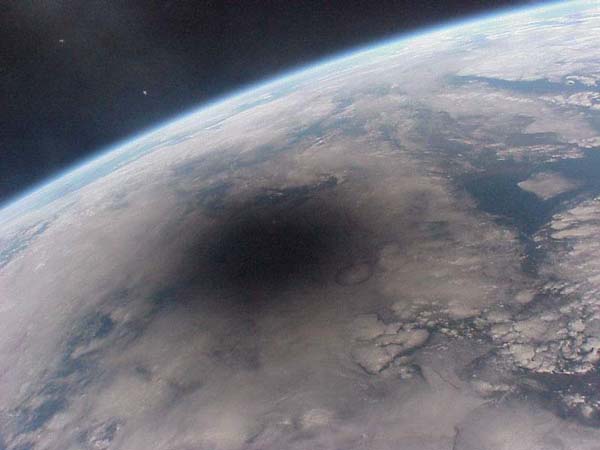The area covered by umbra is the most spectacular of the whole solar eclipse phenomenon, therefore I would like to pay particular attention to this. Because I was watching the totality only once, I am going to use some supporting materials next to my own pictures.
How the lunar shadow looks? We can consider it in three ways:
- What does the lunar shadow shape look like?
- What does the lunar shadow look like from space?
- Is the lunar shadow edge sharp or gentle?
I would like also to answer other questions:
- What does the scene inside the shadow look like?
- How can we recognize a penumbra appearance without looking at the Sun?
- What things modify the umbra’s appearance?
- What improves or impairs an umbral edge?
1. INTRODUCTION
Every celestial body casts a shadow because it blocks an incident light source on its way toward space. For the sake of simplification, we can say, that this shadow extends into infinity, being expressed as a common light level drop by the illumination source. Nowadays a lot of deep space observations concentrated on external planet research are carried out on the basis of a light drop from some particular star. It means, that when some star is blocked by an unknown planet, an instrument such as a Hubble Telescope is inside something like a half-shadow, produced by this unknown planet. An analogous situation occurs during the transits of internal planets across the solar disk as seen from the Earth. A popular kind of observation is the occultation of stars by small asteroids or the Moon when these remote objects lose their light for a brief moment. In Earth conditions, the major culprit of both occultation and a significant daylight weakening is obviously the Moon – a natural satellite of our planet.
The Moon is around 4 times smaller than Earth and around 400x smaller than our mother star at once. Because its average distance to Earth is 400x shorter than the distance of the Sun, we are lucky to experience an awesome total solar eclipse phenomenon from time to time. I will stop this elaboration right now, bearing in mind, that this information is widely common in many encyclopedias, astronomy books, and obviously on the web. Before I start to answer the topic question I would like to say something general about the Moon’s shadow, possible to see during a solar eclipse.
2. TYPES OF UMBRA
There are three main parts of the Moon’s shadow:
- Penumbra – with an extremely large 6000 – 7000 km diameter depends on the eclipse. The area covered by penumbra is partially shaded. A degree of shading depends on the distance from the greatest eclipse. Due to this only a portion of the Moon is in front of the Sun. The area inside the penumbra witnesses a partial solar eclipse.
- Antumbra – this is the area of the shadow beyond the area of the umbra. The Moon is completely in front of the Sun but doesn’t cover the entire Sun. The outline of the Sun (often called a ring) can be seen around the shadow of the Moon. When an observer is located within the antumbra he can see the annular solar eclipse. The extremely big antumbra diameter can reach up to 374 km.
- Umbra – is the portion of the Moon’s shadow, where the Moon completely covers the Sun. The umbra ends the shadow dark cone, which tapers the Earth’s surface. The observer being inside the umbra is able to see a total solar eclipse. At the finish, I will add up, that the maximum diameter for the umbra is up to 273 km.


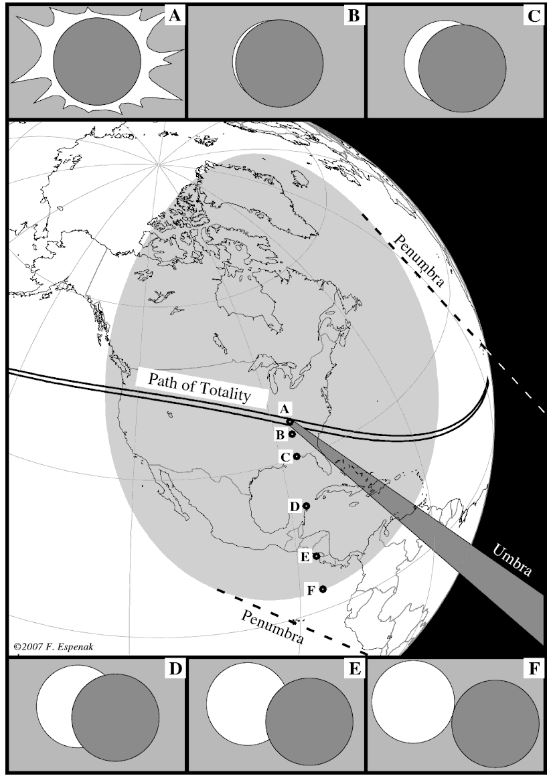
3. UMBRA SHAPE VARIATION
The first thing, that comes to mind is about the general shape of the lunar shadow. Because we know, that the Moon is spherical (for the sake of simplification, because the same as other big bodies of the Solar System the Moon is an oblate spheroid) the shadow should have a circular shape. However, this is an ideal assumption, when totality occurs at the zenith.
All types of umbra listed above feature their particular diameter, which varies because of three major and another three minor factors:
– A lunar distance to the Earth at the moment of eclipse (Pic. 1), which determines not only a penumbra diameter but also the width of the antumbral or umbral regions. The diameters mentioned above refer to their maximum value as can be reached during the most favorable circumstances (when an eclipse occurs at the moment of apogee whilst the Earth is in perihelion or another way round).
– The location of an eclipse phenomenon in the sky. When referring to these maximum values mentioned above we have to bear in mind, that they are valid only for the zenithal type of eclipse. Practically it happens very rarely when the eclipse occurs exactly at the zenith. Usually, the Sun is located lower in the sky, therefore these values, which go without saying, are going to be bigger. I promise to explain this issue more roughly in the future.
– Local circumstances, that are much different between opposite parts of the umbral region. Usually, the extreme areas of the umbral region are quite close to each other during the totality (usually about 100 km or more), although it still makes a difference in the solar position in the sky. Imagine, that each 111 km towards north or south changes the solar altitude every 1 degree. Similar changes are to be observed when moving tens of kilometers in the eastern or western direction. When the eclipse happens close to the zenith is not a big deal, but again, it happens very rarely. When the Sun is lower (further from the zenith), then the local circumstances between opposite parts of the umbra vary more. As a result, we can observe on the eclipse maps and movies, that the umbral shape is oval (looks like an ellipse) (Pic. 6). It is easily discernable when the eclipse occurs near the terminator line, such as a 2015 total solar eclipse at the North Atlantic region (Pic. 5).
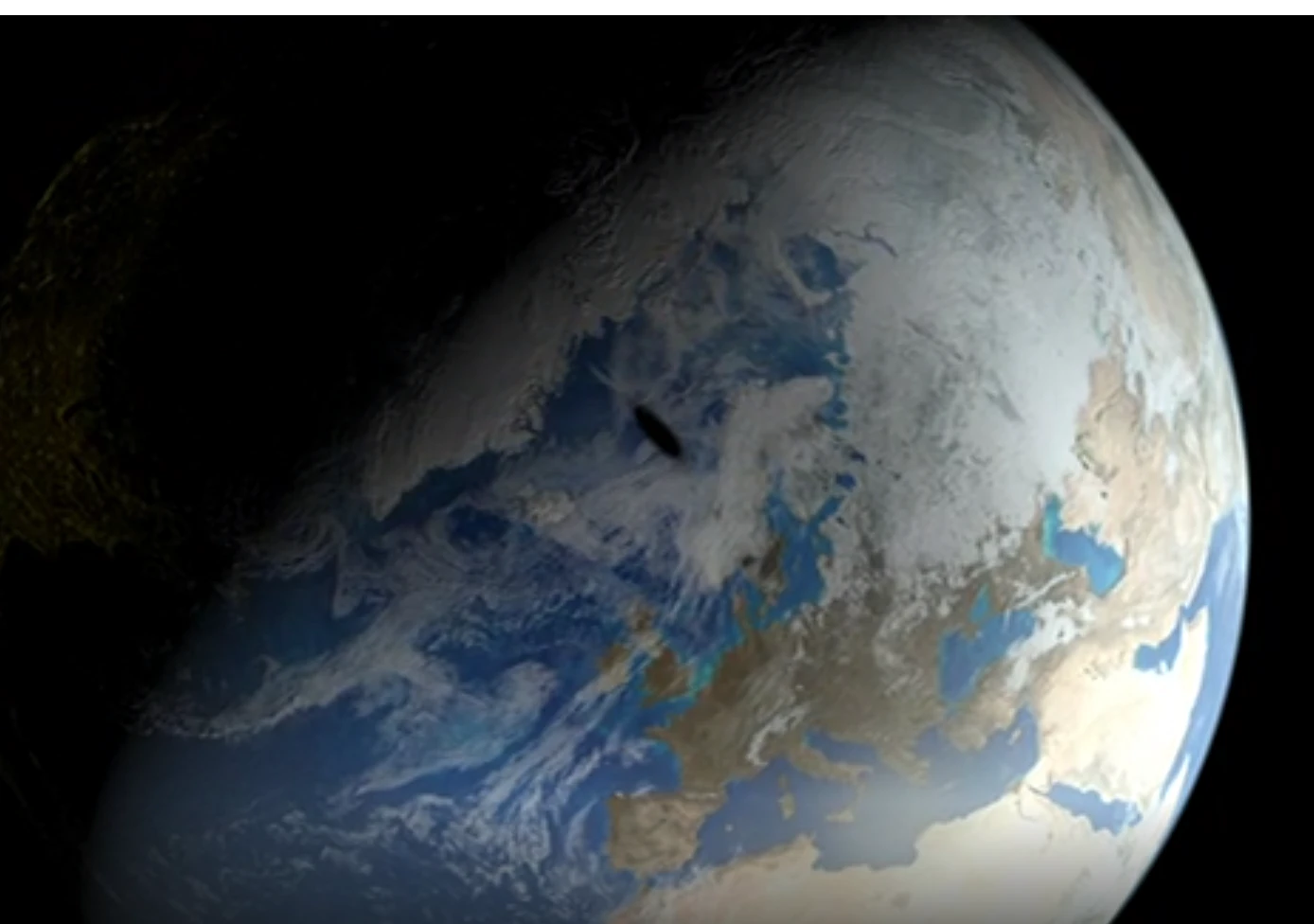

So now, you have got an answer for the 1st question, marked at the beginning of this article. Lunar shadow fleeting across the Earth’s surface during the eclipse looks like an ellipse. The eclipse maps have depicted the lunar shadow as a smooth ellipse on the ground for centuries. The umbra ellipse varies all the time throughout the solar eclipse. Imagine, that just after the moment of first touching the Earth’s ground by umbra this ellipse is very elongated. As the lunar shadow progresses further on its path this ellipse becomes more smooth, reaching the most gentle appearance at the greatest eclipse point. Thereafter the umbral shape changes in reverse sequence until it coincides with a terminator (horizontal solar eclipse). This is an obvious astronomical factor arising out of the lunar movement around the Earth, which will be described in more detail in the future.
For minor factors, we can classify:
– a lunar limb profile (Pic. 1), which determines the real umbra-shaped borders. A lunar limb profile is different for each eclipse. It determines basically an exposure of lunar surface terrain declivity, as we can see from the Earth. Basically, this is a minor thing for umbral shape during the eclipse, which is dramatically elusive. The difference between a smooth limb being a mathematical reference and a true limb, including the lunar topography (Pic. 6) is too small for our further consideration. Moreover, the rough umbral borders are fuzzy and rather impossible to point, due to light scattering. A lunar limb profile is much more important for Baily’s Beads observation and diamond ring effect purposes (Pic. 7), because each edge corresponds to a single valley on the lunar limb. These things I will describe these in the future.
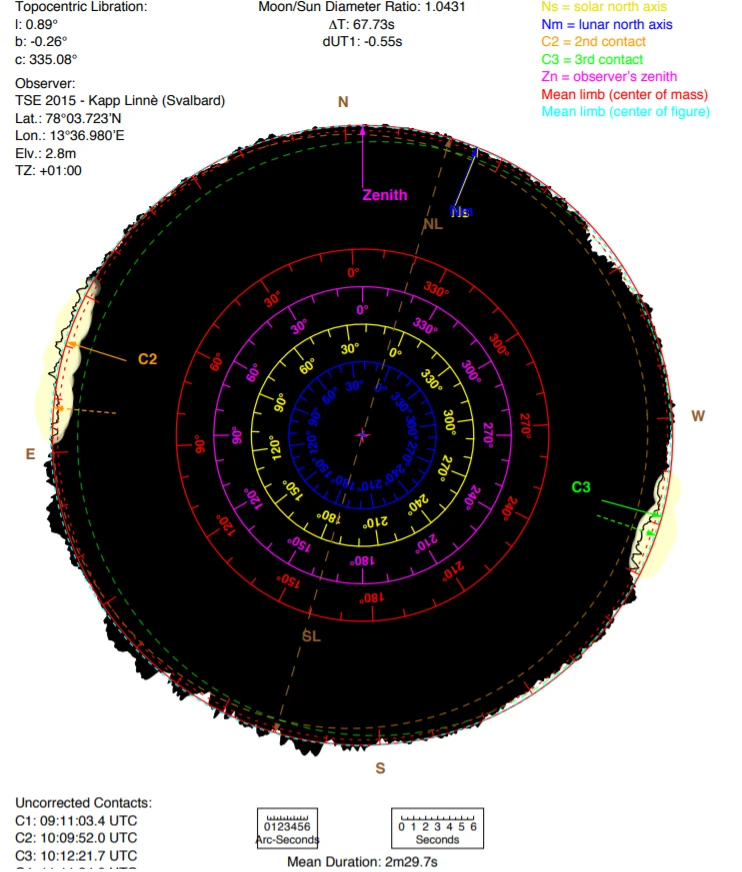
– Earth topography, as well as a lunar limb profile modifies the shape of the umbra, but also not much. I could say, that this factor can be negligible, even if we have high mountains, I think. On the other hand, it can be more important for Baily’s Beads observation, when an observer is placed within the grazing zone, but this is not a thing to look at in this article. Usually, the difference between the true limb and Earth surface alterations is much smaller, than the difference between the smooth limb and the true limb (Pic. 6).
– Earth’s atmosphere, which includes a lot of air molecules, scattering the light as well as cloud coverage, can also modify a shadow shape, but only locally and for a really short period.
4. LUNAR SHADOW SEEN FROM SPACE AND ATMOSPHERE
Describing the appearance of the lunar shadow I will follow the direction from the top to the bottom. Firstly I show you how it looks from space then, next from the atmosphere (meteorological balloon and plane), and finally from an observer’s perspective on the ground.
View of the lunar shadow from the space or atmosphere is the best, as you can witness. Everyone knows, that this is hard to achieve. The view of an umbra from space is reserved for ISS workers only, however, a view of it from the Earth’s atmosphere is conceivable. We can raise a meteorological balloon or book a flight alongside the path of totality. For people keen on seeing the shadow from space a good alternative is taking a look at weather real-time satellite imagery, which often records an umbral movement (Pic. 11).
ISS astronauts are able to see the lunar shadow quite easily because usually, the ISS track passes the eclipse path usually 2-3 times on its route around the Globe. It must be a miracle for the ISS to encounter a full shadow on its way, however, the umbra can be seen from the space station deck. It works thanks to the ISS altitude (about 400 km above ground), which gives it a range of view up to 1709 km. As a result, the fully shadowed fragment of Earth can be seen in a lot of cases, when ISS crosses the area of the eclipse. In the majority of cases, a penumbral area is clearly visible too, even when a full shadow is completely gone or out of range (Pic. 8).
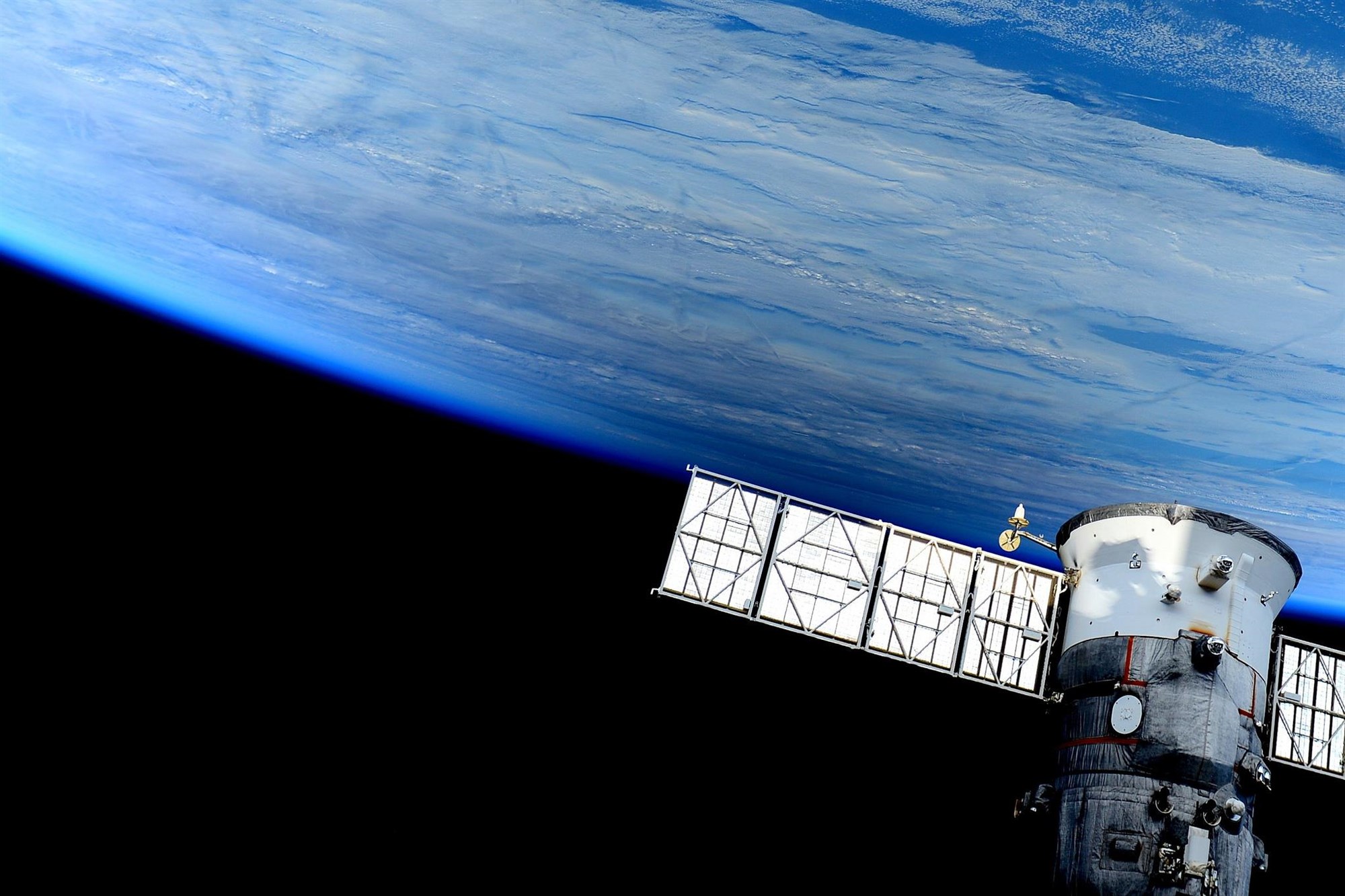
Nevertheless, for us, the most interesting view is the deeply shaded area during a total solar eclipse (Pic. 9 – 11), which has been spotted by astronauts in different configurations against the location of the space station.

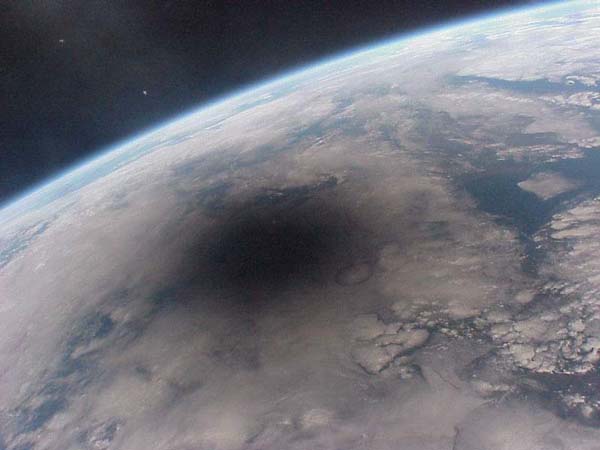
Looking at these two images above you can spot, that an umbra doesn’t have a clear border. Moreover, the area inside the umbra looks completely dark. If you have seen a total solar eclipse before, then you know that it’s impossible to get completely dark during a full phase. I will explain it further in this article. From the outside perspective, the shadowed area looks completely dark, because the light reflected from Earth’s surface, which is outside the totality is much stronger than light scattered by the atmosphere inside the umbra. Apart from a full shadow itself, there is a much wider area of penumbra, experiencing a partial phase of the eclipse. This area encircles an umbral region, making the grey appearance with light fainting down towards the full shadow. The light drop caused by the eclipse is also pretty good noticeable from space, where a range of view covers an area free of eclipse or at least an area with smaller obscuration. Anyway, a penumbral area is much better expressed, when a full shadowed area is outside of the field of view (Pic. 8). This is related to the light transition phenomena, which have been roughly described here. The grey area surrounding the umbra becomes better visible also in the situation when the view range increases. Eventually, it also appears to look black next to the umbra making the lunar shadow bigger in appearance, even when an annular eclipse occurs. This is easy to see on weather real-time satellite maps (Pic. 11), where even at the annular eclipses the dark area is easy to spot. The human eye perception makes the umbra dark along with the surrounding area illuminated by a thin crescent sun only and also antumbra. In consequence is really hard to draw the border between shadowed and illuminated areas. Looking at the umbra from space we can see the circle-looking shape, unlike horizontal eclipses, when the lunar shadow appears to be elliptical.
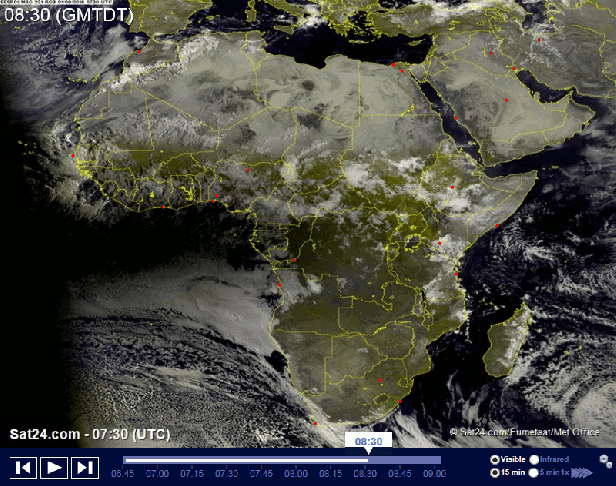
A similar view takes place from a meteorological balloon (Pic. 12), where a view range is still much wider, than the umbra width, and external, sunlit areas bring a huge amount of light, beating up any brightness coming from the inside of the umbral area.

As the altitude is reduced, we start to see some details on the ground inside the shadowed area. It is driven by a shrinking view range, as we are on a lower level. The amount of light, coming from partially eclipsed areas (while an atmosphere also) is weaker because the umbra starts to play a leading role in the field of view, making a light transition phenomenon at once. I think, that the light transition, in this case, should occur somewhere between an altitude of 20-30 km above the ground. However, it varies due to a lot of factors, related especially to the lunar shadow and the length of a total solar eclipse. I believe, that over the next few years, we will have many more pictures of lunar shadows from these altitudes because the observations done through a meteorological balloon are getting popular. It is worth to mention about another, very spectacular situation, which was chasing the total solar eclipse by Concorde plane. It took place in 1973 when the longest record of totality watching (74 min) bounded by an extended second (7 min) and third (12 min) contacts (Beckam et al., 1973) was set. The umbra has been captured from altitude varied between 16,2 and 17,7 km above ground (Beckam et al., 1973) (Pic. 13) and this observation has not been repeated so far.
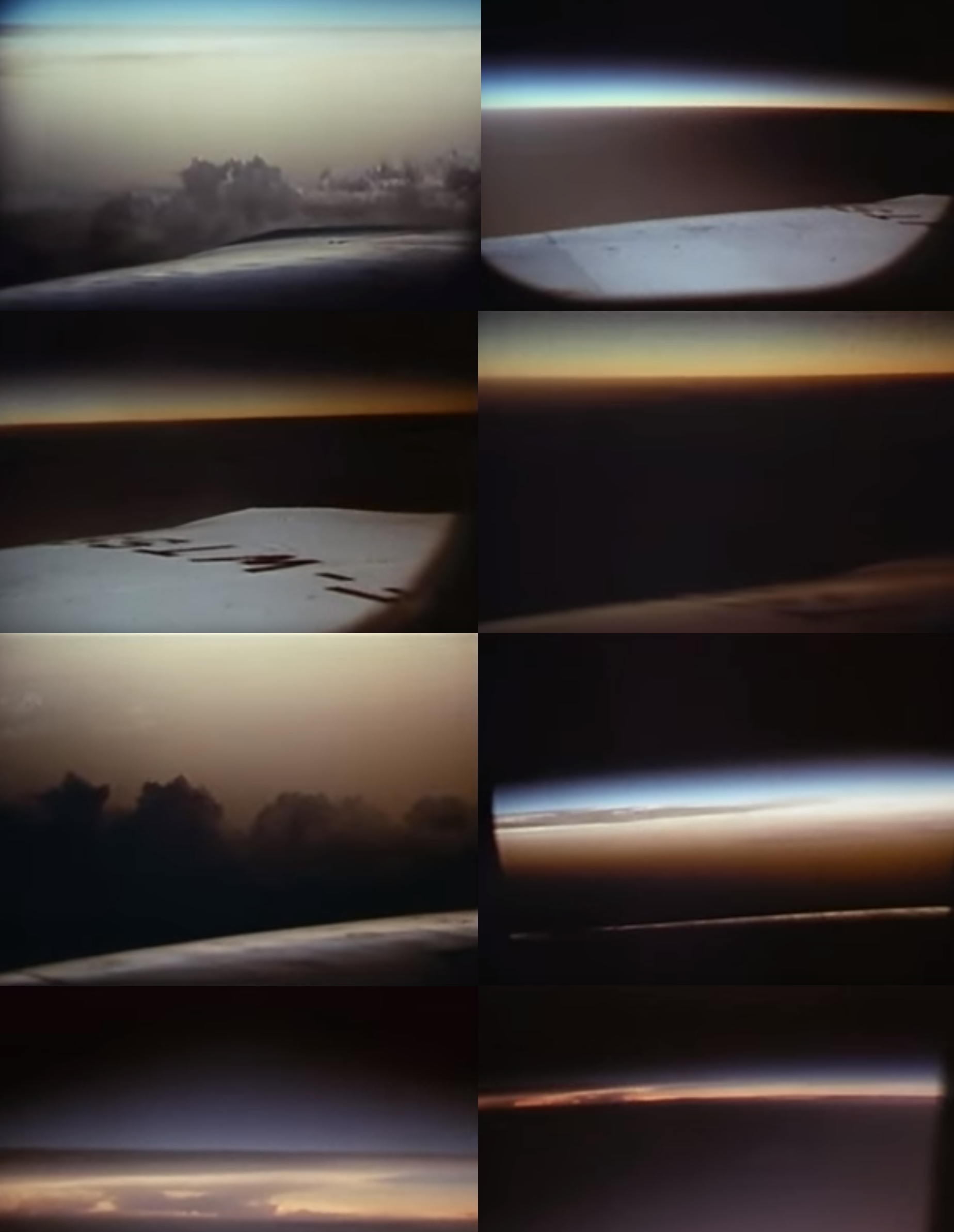
Now take a look at the view, that we can experience more often, namely through eclipse flights. Some eclipse flights are organized and they are aimed at watching this phenomenon from a cruising altitude, which is about 10-13 km above the ground. Sometimes the plane can fly a bit higher, up to 15 km, like Xavier Jubier did during the 2015 total solar eclipse, organizing 3 Falcon 7X XMJ aircraft for this occasion (Stevens, 2016)(Pic. 14).

An eclipse flight brings another advantage, which is a long time of totality. The Umbra fleets with about 4.5 Ma velocity, whereas a commercial craft can fly up to 0.85 Ma. This is about 1/4 speed of the lunar shadow, so the eclipse can be extended up to 25%. This is an issue, which will be developed in the future. I would like to bring some examples of umbral view from the typical cruising altitude, done on 20.03.2015 below (Pic. 15-18).




There are other reports, but again, I will raise another post regarding this in the future. For the time being, I show you an Alaska Airlines example (8.03.2016) (Pic. 18) and the most spectacular – almost hybrid, taken by Been Cooper on 5.11.2013 (Pic. 19).


There are also known images and footage of the lunar shadow captured from the mid-level or low-level cloud deck (Pic. 21, 22).


There is much more footage available on YouTube and other streaming services, where we can take a look at the phenomena related to the solar eclipse. It definitely requires another post about this.
Important is the question – from what altitude can we see a whole umbra shape? The answer is, that the minimum altitude, from which we can see a whole umbra varies then. For the longest eclipse case, where the umbra diameter can count up to 273 km it will be around 5 km above the horizon. However, this is only a mathematical assessment based on the trigonometric functions, because from a practical point of view at altitudes greater than a few kilometers the horizon is indistinct because of contrast reduction, even on extraordinary clear days (Bohren 1986).
Once the eclipse is shorter, like the last one in America this minimum altitude will be accordingly lower, although from a practical point of view, the shadow edges can be hidden behind some mountain ranges, etc.
Anyway, the “safe” altitude, from where a whole umbra eclipse is to be visible is the cruising altitude (Pic. 15 – 18). An airplane passenger flying over an Earth’s surface cannot point to the apparent boundary between Earth and sky but is high enough to see a whole lunar shadow shape on the ground.
Both from the plane and the meteorological balloon we can see a fuzzy edge of the shadow. This is a big contrast between the illuminated and completely shaded areas. As our altitude is higher we won’t be able to see the details on the shadowed ground. This is due to the increasing range of sight of the illuminated area, which blinds the observer and makes the shaded area black appearance.
5. LUNAR SHADOW SEEN ON THE GROUND
Now let’s take a look at the lunar shadow, as it approaches and looks inside. On all maps, animations, and simulations the Moon’s shadow appears to have sharp, strictly determined borders. Does it look the same in reality? The answer is: No! As I wrote above about a gentle transition between illuminated and dark (or black) areas, seen from the upper part of the atmosphere and space, it is also to be observed also on-the-ground reality.
The best view of the lunar shadow from the ground can be reached in some elevated areas. The best places, however with the lowest probability of good weather are high mountains. A view of the umbra can be pretty much similar to this, gained somewhere from the low-level cloud deck level. The best example, as we can see, comes from the group of mountaineers, who decided to observe the 2017 total solar eclipse from the Grand Teton summit. The experience was amazing, we can say, that they were extremely lucky, to have a sky completely free of clouds (Pic. 23).

The view from the Grand Teton summit was jaw-dropped for everyone. Again, the favorable conditions for this kind of observation happen only rarely. Usually, a similar, but less spectacular view an observer can get from lower mountains or some elevated areas when your relative altitude is a maximum of about 1 km. In this event, you won’t be able to see the shadow outline. Instead of it, a considerable ground darkening is to be seen. The ground darkening expresses the irradiation level difference in the seen distance between an observer and some point at the horizon. It is analogous to the cloud deck seen from the plane or helicopter, presented above (Pic. 21, 22).
There is an example of the ground darkening below, related to the full shadow approach. As you will see, there is no sharp umbral edge. Everything goes through such a gentle transition of light, which is scattered during the first and last several seconds of totality. A shadowed edge becomes sharper when is further from the observer due to the perspective effect.
I have no example of the umbral region seen from the elevated mountainous area, but you can see a drone perspective instead of it. This is the view, that I believe will be more popular in future eclipses (Pic. 24).

As you can see both in the view from a high mountain and from some elevated area, the edge of the umbra, despite lack of sharpness, is generally quite easy to determine for the observer on the ground. It can be hard to see the umbral edge when looking at distant mountain ranges. Anyway, because the lunar edge is not sharp, the border between the area illuminated by the vanishing crescent sun and the shadowed area is soft. This is because illumination decrement progresses according to the logarithmic function, the fastest dimming of the light is observed just before the totality as opposed to the fastest brightening just after 3rd contact.
When observing the eclipse on low and flat grounds, the best lunar shadow appearance is to be seen in the sky. However, it is still possible to see some ground-darkening phenomena, especially near the 2nd and 3rd contacts as well as shadow move across the rough land, featuring some huge mountain ranges with a relative altitude of at least a few hundred meters. I was fortunate to capture the fleeting umbra on Owl Creek mountain range (Pic. 25, 26), located about 30-65 km from my observation venue. This range rises up to 1 km above the Wind River Basin.

This observation doesn’t work when hills are too low or lie close to the observation venue. In effect, near the 2nd or 3rd contacts, an observer will see, that some hills are plunged into the shadow, whereas other ones are still a bit illuminated (Pic. 29).
6. LUNAR SHADOW SEEN ON THE SKY
Lunar shadow is easily seen in the sky, even when a total solar eclipse doesn’t take place in a particular location. However, this situation applies to deep partial solar eclipses, when obscuration is higher than about 86% under the transparent atmosphere, free of haze. The lowest magnitude, when I could spot an umbra in the sky was 0,9 (Pic. 27). It was in 2015 in Scotland. I haven’t repeated a view such as this in 2017 due to the high haze concentration in Wyoming.

The obscuration of 86% (magnitude about 0.88) is a moment, when shadow geometrically begins visible above the horizon, taking into account the altitude of the ozonosphere, which response we can see twice a day as a civil wedge, being a border between the belt of Venus and Earth’s shadow. I will describe this phenomenon in the future, although for the time being it’s good to know, that the altitude is about 27-28km, which corresponds to 6 deg horizon dip (a civil twilight border). With respect to total solar eclipses, we can see a similar phenomenon, expressed by abrupt sky-darkening (Pic. 32-35).
In practice is impossible to spot the umbra at this stage of the eclipse, because there are factors, preventing its appearance, like haze concentration and irradiation itself. Nevertheless, when the phase of the eclipse is greater, the shadow may start to be present in the lower part of the sky. It still can not be a full umbra, but an area in its closer vicinity, featuring a sudden light drop, as we observe tens of seconds before the totality. Considering the irradiance weakening towards the umbra, the haze will impair it, making the umbra a bit longer invisible, as the eclipse progresses. For eclipse magnitudes, smaller than 0.88 an umbra won’t be visible, but under favorable conditions, the observer will be able to spot a slight sky darkening as a result of deep penumbra presence.
In Wyoming on the eclipse day, a thick haze disallowed me to see the umbra such “far” from the totality, as I could do in Scotland. Measuring the light I noticed a small light level drop at 0.89 magnitudes (Pic. 28). The umbra started to be visible at about 0.95 magnitudes when it was high enough on the sky to beat up the haze suspended in the planetary boundary layer haze (Pic. 29).


For bigger magnitudes, there is basically no problem spotting a sudden sky darkening towards the direction, where a total solar eclipse takes place (Pic. 31, 32). A person, who doesn’t have a clue about the solar eclipse phenomena can see it from a distance of about 250 km from the path of totality without the problem, especially under favorable geometric conditions, as occurred on 20.03.2015 for some locations. Obviously, it applies to a transparent atmosphere, free of haze and consistently for antisolar direction, where backward scattering takes place. The minimum distance, from where the umbra can be visible to an observer is about 100 km in cases, when shadow cone fleets “under the Sun” in the sky, under a high level of haze concentration such as 21.08.2017 in Wyoming.
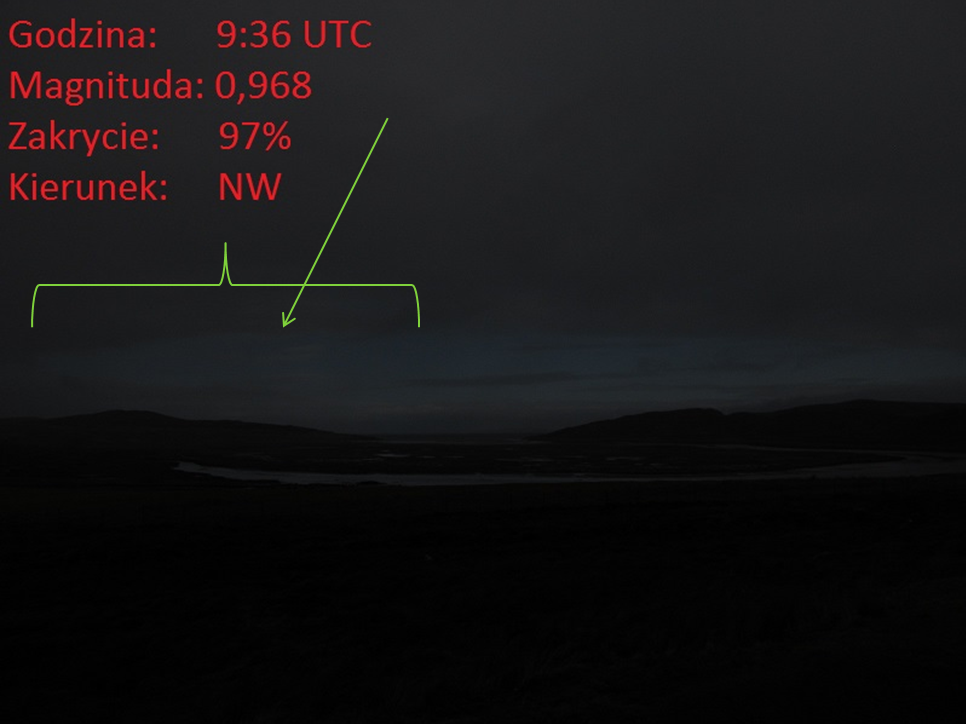

The best appearance of the umbral column occurs obviously when the observer is as close as possible to the path of totality. Usually, it takes place for obscuration higher than 99%, when both sunlight is weak and the distance to the umbra is low (usually tens of kilometers) (Pic. 33).

In those cases, sunlight is too faint to drown out the umbra’s appearance. Apart from this, there is only a small amount of illuminated haze or atmospheric molecules between an observer and the shadowed region, so the umbra has a dark grey instead of bluish appearance, as an observer can see it from a bigger distance (Pic. 22, 30-32). In Pic.33 the Sun was too low to produce a grey shadow cone, that should be visible under a higher solar position, which has been described later in this article.
An analog view occurs when shadow approaches from the antisolar direction, as I could see during the 2017 Great American Eclipse. Then you can easily distinguish a single layer in the atmosphere, being covered by an umbra (Pic. 34 – 36). For the sake of simplification, these layers are the ozone layer (sky), the upper troposphere (high-level clouds), and the lower troposphere (planetary boundary layer).


A similar situation takes place in the reverse sequence, just after the totality. Important is, where roughly shadow is heading. In my observation case, when the Sun was located in the southeast, which was pretty much the shadow-out section of the sky, a shadow appearance was incredible. A light transition moment right after the total eclipse produced a perfect shadow cone appearance, which looked intensively grey against other parts of the sky (Pic. 37). This grey color became brighter as the solar crescent got thicker. Everything lasts about the first tens of seconds after totality.

A shadow cone captured by the camera with fixed photo parameters looks different than on snaps gathered from the footage, where ISO sensitivity adjusts effectively to the changing illumination of the scene (Pic. 38, 39). Unfortunately, both pictures from the camera and snaps from footage cannot reflect a real phenomenon, as the observer can see with the naked eye.


A shadow cone is visible due to the fleeting light transition dividing the air molecules still illuminated by the crescent sun from those, already been shadowed. This expression is enhanced under hazy conditions, where light scattering conditions are more favorable. A key role here plays a forward scattering, which can significantly wash out an initial color of the sky, making it very faint. That’s why the sky around the totality includes a lot of greyscale tints.
A shadow cone is also visible in the antisolar direction, especially under hazy conditions, however, a backward light scattering doesn’t emphasize this phenomenon as a forward light scattering does.
Before I describe the situation, what happens inside the umbra I would like to show an umbra movement on clouds, as seen from outside of totality. Theoretically, shadowed high-level clouds we should see from about 380 km distance, knowing that they are suspended around 10 km above the ground. Likewise, with shadow appearance, the shadowed clouds cannot be visible from this distance, because of a huge amount of light scattered on molecules and haze, which makes these clouds appear fainter, according to Beer-Lambert Law. To see the umbra fleeting on the high-level cloud deck an observer must be at least about 150-200 km from the path of totality (Pic. 40). Think, from what distance are you able to see a thunderstorm cloud. It works pretty much the same. When the atmosphere is clear, then this is possible when there is a lot of haze in the air, then this view from 80 km will be a miracle. In another case, this view can be gained from even a 250 km distance. Taking into account the almost total solar eclipse that occurred in southern Iceland on 20.03.2015, the umbra fleeting on clouds was seen from almost 200 km distance! Air masses coming to Iceland from the north or northwest are very clear, that is the reason.
It’s worth knowing, that even when the full shadow is out of range, the high-level clouds clearly show the difference in illumination within a deep penumbra (Pic. 40). It can be seen much further from the area, where totality is expected.

It won’t work for mid-level and low-level clouds if you set at least tens km from the path of totality. On top of that, on this level of clouds umbra is more elusive.
When you are set on the path of totality, sooner or later you will be inside the umbra. The view of the lunar shadow from the inside is much different than we can see being outside from the totality. First of all, this is a different relation to illumination. When outside the lunar shadow we have a primary light source, which is the Sun and there is no other illumination source, which can be stronger (except for instance some street lamps, that has only a local, minor impact). Inside, the situation is another way around, especially, when you are in the middle of the shadow. Then you often experience more than the primary illumination source, which is a light scattered in the atmosphere. Saying primary illumination source I mean not a point illumination source, as the Sun is, but something like a block illumination source, which corresponds to the entire section of sky, giving a diffused radiation towards the observer.
Another key thing is a light transition, which happens around 2nd and 3rd contact. It turns a shadowed area from the “grey abyss” into a clearly visible twilight sky and another way round at the end of totality. As you may have noticed i.e. on Pic. 33-36,40 there is basically no visual information from the “inside” of an umbra because the scattered light is drowned out by direct light, coming from the Sun onto the penumbral region. Being in the umbra both internal and external area is clearly visible, analogically to civil twilight, about which I will write more in the future.
In the sequence below you can see step by step how the lunar shadow moves across the sky, clouds, and haze (atmosphere boundary layer) (Pic. 41,42). It’s clearly shown, that depending on the altitude, against the observer in conjunction with the stage of totality, the umbral appearance is slightly different. Returning to the umbral movement seen on the hills, the case of the closer and smaller butt has been mentioned.
The most important thing, that you can see there is the brightness. As I said previously, inside the umbra a vista remains in the civil twilight conditions. You are still able to clearly see the items around you and even read the book! However, it can be quite tricky, especially when the font is not big enough. There is an Eclipse Reading Chart, prepared by Rice Space Institute, which provides a lot of font sizes, being readable during the partial phase and totality (Pic. 44). Everything depends on the totality length, umbral depth, and weather. These 3 major factors determine the ability to read text when a total solar eclipse occurs.
Moreover, inside the umbra, you can also experience a shifting illumination source as the eclipse progresses, which you possibly can spot in the picture sequence below. This phenomenon has been already explained here.


In other footage, we can see the symmetry between the greatest phase of the eclipse. It covers both the totality and deep phase of the eclipse from magnitude 0.9 upwards (Pic. 44). This symmetry can be gained when your camera is headed toward one fixed direction. In this case, it was close to the shadow-in direction (northwest).

Interesting is a view of the lunar shadow movement in the negative colors (Pic. 45).

Apart from footage shots, which feature the ISO sensitivity changes throughout the eclipse event, I prepared also panoramic photos from inside of the umbra, which has been done with fixed parameters: 1/20 sec exposure and f/4.5 aperture (Pic. 46).


The best way to capture a whole sky during the eclipse is using an all-sky camera or at least a fish-eye perspective (Pic. 48). Having a view of the entire sky, we can roughly see how the umbra looks at the particular moment of the eclipse.

Using all-sky pictures to capture the total solar eclipse phenomena is a good way to display a lunar shadow geometry, which varies primarily due to the sun’s altitude. That’s a separate matter, which will be described in the future.
7. THE PENUMBRA APPEARANCE
Except for the umbra, which view is one of the most spectacular during the solar eclipse for sure, many more observers experience a penumbra appearance. It applies not only to eclipse chasers but also to casual people seeing this phenomenon far out from the biggest phase. Previously I have focused on penumbra only when the magnitude is very big and we experience a deep phase of the eclipse when the umbra is visible to an observer. Now I would like to show generally, how the illumination changes throughout a whole partial solar eclipse phase. As the lunar disk progresses across the Sun, we can see illumination changes. The truth is, that lots of people don’t realize, that radiation changes. The reason for it is the same illumination decreasing both for the sky, surrounding vista, and illumination source. A human eye adapts to the “new” conditions then, nevertheless of the eclipse magnitude. It changes usually when the eclipse phase is deep enough and the primary illumination source can be compared with some fixed light available nearby.
The illumination changes can be recorded easily with fixed EXIF parameters, even from the early stage of the eclipse (Pic. 49 – 51).



A slightly different result can be gained when recording a light level drop with a flexible ISO sensitivity. Even here, the changes are noticeable at the early stage of the partial phase of the eclipse, although these changes are more expressed with sky tint instead of the light drop itself (Pic. 52 – 54).


As you have noticed, the difference between the images with fixed ISO sensitivity and flexible ISO sensitivity is considerable. Basically, upon 85% obscuration, the illumination difference between both the sky and the scene is quite small. This is because the camera was adapting effectively to the light level changes as well as the human eye and most camcorders do, a good example is one of the pictures above (Pic. 44), showing the changes from 90% obscuration upwards. On the other hand, an eagle eye can detect the illumination changes at the moment of about 50-60% obscuration, which corresponds to the morning-evening sunlight conditions, whereas the cameras can detect this difference much earlier, even for 30-40% obscuration, what can be seen on the aforementioned photo sequences (Pic. 52-54).
8. CONCLUSIONS
In general, I have answered all the questions marked at the top of this article. Now I would like to summarize this whole essence, bringing key things, that can be useful for all eclipse chasers in the future.
Basically, the lunar shadow looks like a fuzzy dark area from space or a meteorological balloon. Its edge appears also as a blur and gently “line” between illuminated and shaded areas.
The umbral border is quite easy to spot, however, there are factors, that can improve or impair the view of the umbral border. The components improving a view of the umbral edge are:
- High-level clouds, reflect the sunlight perfectly. Around the totality is easy to spot a darkening gradient of cirrus, cirrostratus, and altostratus clouds, that terminates at the discernable, however fuzzy border of the shadow
- A high level of haze, that clearly marks an umbral border on the sky and surroundings
On the opposite side are the circumstances, which make the umbra edge more difficult to spot. There are:
- Low-level clouds, where due to the short distance to the observer the umbral edge is more fleeting. We can see the umbral edge only when is closer to the horizon.
- Fog, which makes it almost impossible to see the umbral edge due to light scattering on droplets, being much bigger than light wavelength,
- Far mountain ranges, where the shadow border coincides with the darkening atmospheric boundary layer. Basically is harder to distinguish the border between illuminated and non-illuminated areas also due to light scattering on haze and atmospheric molecules, which tend to make the most external parts of the shadow brighter.
Inside the umbra is not completely dark. This issue has been raised in previous articles. I also found that the light level varies throughout the totality due to light scattering on aerosols in the atmosphere. The light secondly scattered on the atmospheric aerosols blurs the umbral edge, letting the scattered light go through the shadow cone. The basic, although simplified principle is, that when closer to an umbral edge then it is brighter. This is clearly seen especially when looking at the shaded remote mountain ranges, whereas the Moon’s shadow progresses the contrast changes differently in each part of the range (Pic. 24-26).
Concluding, the Moon’s shadow features a gentle transition between the illuminated and shaded areas. The umbral edge is not sharp, however, is quite easy to spot, especially in the sky, clouds, and haze. The umbral interior is nonuniform in illuminance level due to the distribution of solar light, scattered by clouds, haze, and atmosphere outside the shadowed region. Comparing the extremal parts of the totality to the around mid-eclipse moment the illumination difference is quite big.
A penumbral region usually doesn’t feature a lot of illumination changes in the scene unless the eclipse magnitude is considerable. It arises out of effective eye adaptation to new conditions. This efficient adaptation applies also to camcorders and cameras. In this event, we can see small changes in sky tint instead of diminishing the light.
Mariusz Krukar
References:
- Beckman J., et al., 1973, Eclipse flight of Concorde 001, (in:) Nature – International Journal of Science, vol. 246, p. 72-74.
- Bohren C. F., 1986, At what altitude does the horizon cease to be visible?, (in:) American Journal of Physics, vol. 54, issue 3
- Stevens L., 2016, Totality – The digital magazine for eclipse-chasers, issue 14
Links:
- Lunar limb profile
- Is the Moon spherical?
- How ISS astronauts saw the 2017 eclipse
- NASA: ISS observations
- A report of 2015 solar eclipse seen by ISS astronauts
- Live streaming from International Space Station
- Total solar eclipse 2017 seen from the meteorological balloon (APOD)
- The concorde and the longest solar eclipse
- 2015 total solar eclipse – stratospheric flight
- 2015 total solar eclipse seen from the stratosphere (private jet)
- 2016 Alaska airlines total solar eclipse seen from the plane
- 2019 total solar eclipse flight
- 2019 total solar eclipse flight – details
- Watching an eclipse from the plane
- Measuring dimming daylight
- NASA/Rice Space Institute: Eclipse reading chart
- Rice Space Institute: Eclipses section
Wiki:
Youtube:
https://www.youtube.com/watch?v=hNM95J8Nb3w
Other media:
https://vimeo.com/122780298 – 2015 solar eclipse seen from the helicopter
Read also:
- Deep partial solar eclipse in Scotland
- African “Ring of fire” on the live stream and web cameras
- Light level measurements during total solar eclipse
- TSE2017: Shadow movement across the sky

